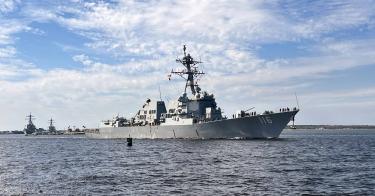A significant amount of money could be spent on ordering warships this coming year. Still, we also need to work on reversing the retirement of many warships that occurred under President Biden.
This reversal is all the more necessary when you consider what has been proposed for fiscal year 2026: the procurement of just 19 warships. That’s wholly inadequate given the growing dangers we face from our adversaries.
America Needs More Warships to Defend Itself
Think China is a good neighbor? So far this year, it has tested a massive mobile pier for invasion of Taiwan, landed forces on the Philippines’ Sandy Cay, and sustained large-scale provocative military operations in the Taiwan Strait. As its decades-long military modernization and expansion proceed at a rapid pace, from 395 warships today to a fleet of 435 modern warships by 2030, there is little reason for Beijing not to push boundaries.
When our nation was confronted with revanchist foes in the 1930s, the President and Congress implemented the Naval Act, which set conditions for industrial expansion, enabling the arsenal of democracy to win World War II. As in the 1930s, we again need a Naval Act to revive our naval shipbuilding before it is too late.
>>> MARAD Is a Mess, and That’s Bad News for Our Maritime Revival
Today, our Navy musters 293 warships, according to the most recent Index of Military Strength, which is rapidly aging and nearing retirement for a fleet that is currently assessed as too weak. Moreover, according to its most recent 2023 fleet plan, the Navy is short one aircraft carrier, 19 attack submarines, two cruisers destroyers, and 47 frigates. There is a risk in maintaining the status quo.
America Needs a New Naval Act
A Naval Act today, as it did in 1938, can grow the nation’s naval shipbuilding capacity for a potential war with China. Such a commitment shields shipbuilders from vacillating and tardy budgets that have retarded needed capacity investments.
A modern naval act, echoing the nation’s historic success in preparing for war in the Pacific, would galvanize meaningful action. This growth would be driven by orders for more warships of designs already in production. This demand would fuel shipyard expansion, which is critical if war becomes inevitable with China as early as 2027.
Ordering warships in multiples, known as block buys, provides efficiencies that result in savings. Recent experience indicates savings of up to 15 percent. The Congressional Budget Office notes that the cost of warships increased by upwards of 10 percent as building proceeded and delays ensued.
This situation persists in part because shipbuilders and the Navy are encouraged to underbid the initial costs. It is far better to lock in the costs, even if they are higher upfront, than to suffer infuriating and politically unsustainable piecemeal increases and incipient delays due to labor and shipyard limitations.
A Naval Act today would fund a large order of warships based on the planned purchase of ships. This would be based on the most recent long-range shipbuilding plan’s Future Years Defense Program (FYDP), which includes: 10 destroyers, 7 frigates, 10 attack submarines, 4 ballistic missile submarines, 3 amphibious transport docks, 1 amphibious assault ship, and 6 oilers. Total cost in fiscal year 2025 dollars: $150.56 billion.
>>> Modernizing America’s Nuclear Arsenal
That’s too big a slice of the Department of Defense’s budget pie to work in the nominal National Defense Authorization Act, making a stand-alone bill appropriate. Given Congress’s record of supporting naval shipbuilding, there appears to be a political appetite for reviving the nation’s shipbuilding efforts.
How Can the Navy Afford So Many New Warships?
However, to enable the Navy and the shipbuilders to make the best engineering decisions and capital investments, a new contracting mechanism is needed: Shipyard Accountability and Workforce Support (SAWS). This isn’t a novel approach for commercial, large, and capital-intensive projects, but it’s not how Congress and the Navy run naval shipbuilding.
SAWS enables the Navy to authorize funds for future yearly ship procurement to shipbuilders, thereby growing capacity and workforce in anticipation of planned orders, which helps prevent delays and cost overruns. Of course, this must come with stronger accountability for underperforming shipyards.
Moreover, Congress is considering the Building SHIPS for America Act to revive the nation’s lackluster commercial shipbuilding sector. This bill is currently in committee, and one idea from that effort that should be applied to naval shipbuilding is a Distributed Profits Tax. This would reward shipbuilders by waiving taxes on profits reinvested in the workforce or shipyard infrastructure, meeting a critical need to grow shipyard capacities.
As Congress debates the President’s Big Beautiful Bill, consideration is likewise warranted for a big beautiful block buy of warships. After 30 years of underinvestment in naval shipbuilding by the US, and China acting increasingly confidently and boldly, innovative action is urgently needed.
A new Naval Act is the big, beautiful block buy that can get naval shipbuilding ready for potential war this decade.
This piece originally appeared in The National Interest




